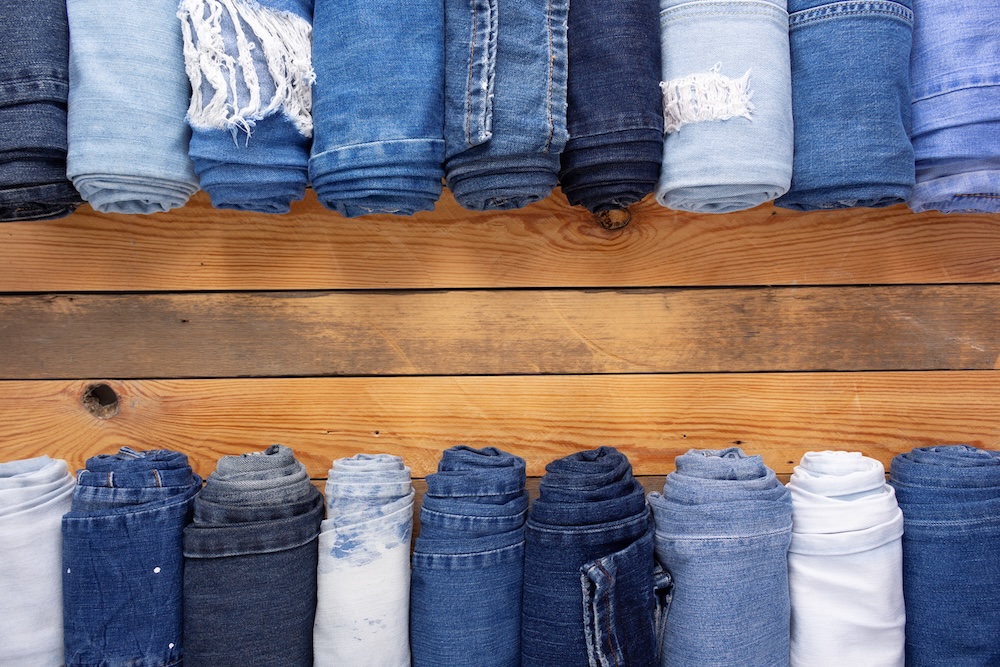Blue jeans are an icon of fashion, comfort, and identity. But behind every pair of distressed denim is a story of hidden costs — to water, to workers, and to the planet. Denim supply chains are some of the most chemical- and water-intensive in fashion, and the global demand for faded, torn, and “worn-in” jeans magnifies the problem.
When denim is distressed for style, the planet ends up distressed in reality.
Denim’s Massive Water Footprint
- One pair of jeans requires 7,500–10,000 liters of water to produce — from cotton farming to dyeing and finishing.
- Cotton, denim’s foundation, is grown with heavy pesticide and fertilizer use, depleting rivers and contaminating soils.
- In regions like India and Pakistan, water diverted for cotton has already stressed aquifers and ecosystems.
The iconic “blue jean” is also one of the thirstiest garments on the planet.
Toxic Dyeing and Processing
Indigo, the dye that gives jeans their classic blue, has largely shifted from plant-based origins to synthetic production.
- Synthetic indigo requires toxic chemicals such as aniline and sodium hydrosulfite.
- Wastewater from dye baths is often discharged untreated, turning rivers blue and poisoning aquatic life.
- Denim hubs like Xintang, China — known as the “denim capital of the world” — have documented cases of rivers so polluted that water is undrinkable and crops fail.
The “blue” in blue jeans is often a reflection of blue-stained rivers downstream.
Distressing the Environment
Distressed jeans — ripped, faded, stone-washed — are created through processes that magnify harm.
- Sandblasting: Propels silica dust that causes lung disease (silicosis) in workers.
- Acid washes and bleaching: Use chlorine and potassium permanganate, hazardous to both humans and ecosystems.
- Stone-washing: Requires pumice stones and high water volumes, producing slurry waste difficult to manage.
The very fashion effect meant to mimic natural wear is anything but natural.
Supply Chain Inequities
- Denim production is concentrated in low-cost labor regions where regulations are weak.
- Workers often lack protective equipment, exposing them to toxic dust and chemicals daily.
- Wastewater from factories is discharged into local rivers that communities rely on for drinking, farming, and fishing.
Distressed denim is marketed as effortless, but the stress is borne by unseen workers and their environments.
The Bigger Picture
Globally, denim represents a significant share of fashion’s environmental toll:
- The industry produces over 4 billion pairs of jeans annually.
- Denim alone is responsible for an outsized share of water pollution within textile manufacturing.
- Fast fashion accelerates turnover — distressed jeans are often treated as disposable despite their heavy footprint.
When multiplied across billions of pairs, even small inefficiencies create planetary-scale damage.
Sustainable Alternatives Emerging
While no pair of jeans is impact-free, better approaches exist:
- Waterless dyeing: Technologies like foam dyeing reduce water use by up to 90%.
- Ozone fading: Replaces harsh bleaching with ozone gas, which breaks down safely into oxygen.
- Laser distressing: Mimics rips and fades without sandblasting or chemicals.
- Organic and recycled cotton: Cuts pesticide use and reduces water demand.
- Closed-loop recycling: Brands experimenting with take-back programs to recycle fibers into new denim.
These methods show progress, but adoption remains small compared to the billions of pairs still made conventionally.
What Consumers Can Do
- Buy fewer, better jeans: Choose durable denim you’ll wear for years.
- Skip the distressed look: Distress jeans through wear, not industrial processes.
- Check for certifications: OEKO-TEX, GOTS, or Bluesign signal reduced chemical use.
- Support transparent brands: Companies investing in waterless dyeing and safer distressing deserve consumer demand.
Fashion should never cost rivers, lungs, or ecosystems their health.
FAQs
Why are distressed jeans so damaging?
Because the “worn-in” look is created with water- and chemical-intensive processes, not natural aging.
Can denim ever be sustainable?
Yes, with waterless dyeing, recycled cotton, and circular systems, but mass production still makes impact reduction a challenge.
Is synthetic indigo worse than natural?
Synthetic indigo relies on petrochemicals and toxic additives, while natural indigo has scaling limits but fewer environmental toxins.
How can I reduce denim’s footprint?
Buy fewer pairs, choose quality over trends, and wash less often to extend life.
Final Thoughts
Blue jeans are more than fashion — they’re a mirror of our values. Distressed denim may be trendy, but its environmental cost is undeniable. Behind the faded seams and torn edges are polluted rivers, wasted water, and stressed ecosystems.
Fashion should tell a story of creativity, not exploitation. By rethinking our relationship with denim, we can move from distressing the planet to protecting it.









Reader Interactions